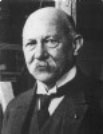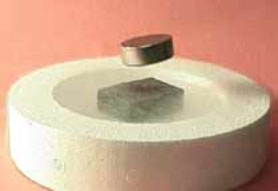|
The Tevatron is an alternating gradient synchrotron and remains, at least for a few more years, the most powerful particle accelerator in the world. It is the fifth and last accelerator in the Fermilab chain of accelerators. The Tevatron takes 150 GeV protons and antiprotons from the Main Injector (transferred through the P1 and A1 transfer lines) and accelerates them to .98 TeV.
Tevatron History
The Tevatron was commissioned in the spring of 1983. By July of 1983, it broke the world record with a man-made particle energy of 512 GeV. It went on to break that record many more times. When it was first commissioned, the TeV was referred to by several names: the Saver, the Energy Saver, and the Doubler. It was called the Saver because of its ability to save a tremendous amount of electrical energy in comparison with the electricity needed to power a conventional magnet. It was called the Doubler because it eventually doubled the old Main Ring's energy of 400 GeV. It is able to do this because of its cryogenically cooled superconducting magnets.
Temperature
William Thomson Kelvin (1824-1907) was a British physicist and mathematician. He designated a scale of thermodynamic temperature that used absolute zero as its beginning point, rather than a scale referenced to a particular substance as many other scientists of his time did. On Kelvin's scale, room temperature is ~ 300ºK, or more correctly 300 K. Here are some common reference points:
| Fahrenheit |
Kelvin |
| -459.67ºF = Absolute Zero |
0ºK = Absolute Zero |
| 32ºF = Triple Point of Water |
273.16ºK = Triple Point of Water |
| 212ºF = Boiling Point of Water |
373.14ºK = Boiling Point of Water |
A Brief History of Superconductivity
 In 1911, Heike Kammerlingh Onnes, a Dutch physicist, began studying the effects of exceedingly cold temperatures on metals. It was already known that the electrical resistance in cold metals lessened. Many scientists wondered if there was some limit to this. William Kelvin had said that when the temperature of the metal reached absolute zero, all electron flow (current) would stop. Onnes though thought just the opposite; he believed that all resistance to electron flow would stop. While measuring the current through a mercury wire, he slowly cooled the wire with liquid helium. Around 4.2 Kelvin, all resistance stopped and the current flowed freely and continually - he ran one experiment for a year with no change in current. Onnes called this electrical property a "superconductive state." Onnes won the Nobel Prize for this discovery in 1913.
In 1911, Heike Kammerlingh Onnes, a Dutch physicist, began studying the effects of exceedingly cold temperatures on metals. It was already known that the electrical resistance in cold metals lessened. Many scientists wondered if there was some limit to this. William Kelvin had said that when the temperature of the metal reached absolute zero, all electron flow (current) would stop. Onnes though thought just the opposite; he believed that all resistance to electron flow would stop. While measuring the current through a mercury wire, he slowly cooled the wire with liquid helium. Around 4.2 Kelvin, all resistance stopped and the current flowed freely and continually - he ran one experiment for a year with no change in current. Onnes called this electrical property a "superconductive state." Onnes won the Nobel Prize for this discovery in 1913.
Walther Meissner and Robert Ochsenfeld found, in 1933, that a superconductor cooled to its critical temperature would produce a magnetic field that would not allow another magnetic field to enter. Later, this was called the "Meissner Effect."
There are two types of superconducting elements. Type I consists of such elements as mercury, lead, aluminum, and tin, who's critical temperatures range from just above absolute zero to 7.8 K at standard pressure. Other elements fall into this type, but they require high pressures. A rare earth magnet placed on a Type one element would levitate, but it would also slide off unless the superconducting material was shaped to contain it. Type II elements are made up of metallic compounds that show superconduction at higher critical temperatures. The highest temperature superconductors, which go into this state at 135 K, are actually considered ceramics.
Here's an example of how magnetic fields interact that you must have done at some time in your life: trying to bring two rare earth magnets together.  If you had the magnets oriented positive pole to negative pole they clamped together. If you had them negative to negative pole the repulsed each other in an uncontrollable way. In both cases, you could see and feel how the magnetic fields reacted to each other. Now, if you took that same rare earth magnet and brought it into the field of a Type II superconductor, the magnet would levitate (as in the picture) and stay at some distance above the superconductor. Here is a Web site that demonstrates this "Meissner Effect": http://www.fys.uio.no/super/levitation/. The rare earth magnet doesn't slide off because of another aspect of the "Effect" called "Flux Pinning." There is, of course, much more to superconduction than what's been explained here. Without going into detail, there are three important factors to superconduction: critical temperature, the magnetic field, and the current density, all of which must be balanced or the element loses its superconductive state. If you had the magnets oriented positive pole to negative pole they clamped together. If you had them negative to negative pole the repulsed each other in an uncontrollable way. In both cases, you could see and feel how the magnetic fields reacted to each other. Now, if you took that same rare earth magnet and brought it into the field of a Type II superconductor, the magnet would levitate (as in the picture) and stay at some distance above the superconductor. Here is a Web site that demonstrates this "Meissner Effect": http://www.fys.uio.no/super/levitation/. The rare earth magnet doesn't slide off because of another aspect of the "Effect" called "Flux Pinning." There is, of course, much more to superconduction than what's been explained here. Without going into detail, there are three important factors to superconduction: critical temperature, the magnetic field, and the current density, all of which must be balanced or the element loses its superconductive state.
Over the years, scientists discovered other materials that exhibited the superconducting property at higher temperatures. Westinghouse scientists developed a commercial available superconducting wire in 1953, made of a titanium-niobium alloy. The British Rutherford-Appleton Laboratory made the first high-energy particle-accelerator electromagnets of copper-clad niobium-titanium in the 1960s. Fermilab built the first superconducting accelerator, the Tevatron.
The Tevatron ring has a radius of 1000 meters. The tunnel is about eight foot high and ten foot wide. There are 30 service buildings and 30 refrigerator buildings. The tunnel contains 774 twenty-foot dipole magnets and 216 quadrupoles magnets.
Accelerator Update Archive
More Information
For Tevatron luminosity charts and the current status of Fermilab's
accelerators and detectors (live!), please go to Fermilab Now
Comments and Suggestions
What do you think about the Accelerator Updates? Please send comments and suggestions to: accelupdates@fnal.gov.
|  In 1911, Heike Kammerlingh Onnes, a Dutch physicist, began studying the effects of exceedingly cold temperatures on metals. It was already known that the electrical resistance in cold metals lessened. Many scientists wondered if there was some limit to this. William Kelvin had said that when the temperature of the metal reached absolute zero, all electron flow (current) would stop. Onnes though thought just the opposite; he believed that all resistance to electron flow would stop. While measuring the current through a mercury wire, he slowly cooled the wire with
In 1911, Heike Kammerlingh Onnes, a Dutch physicist, began studying the effects of exceedingly cold temperatures on metals. It was already known that the electrical resistance in cold metals lessened. Many scientists wondered if there was some limit to this. William Kelvin had said that when the temperature of the metal reached absolute zero, all electron flow (current) would stop. Onnes though thought just the opposite; he believed that all resistance to electron flow would stop. While measuring the current through a mercury wire, he slowly cooled the wire with  If you had the magnets oriented positive pole to negative pole they clamped together. If you had them negative to negative pole the repulsed each other in an uncontrollable way. In both cases, you could see and feel how the magnetic fields reacted to each other. Now, if you took that same rare earth magnet and brought it into the field of a Type II superconductor, the magnet would levitate (as in the picture) and stay at some distance above the superconductor. Here is a Web site that demonstrates this "Meissner Effect":
If you had the magnets oriented positive pole to negative pole they clamped together. If you had them negative to negative pole the repulsed each other in an uncontrollable way. In both cases, you could see and feel how the magnetic fields reacted to each other. Now, if you took that same rare earth magnet and brought it into the field of a Type II superconductor, the magnet would levitate (as in the picture) and stay at some distance above the superconductor. Here is a Web site that demonstrates this "Meissner Effect":